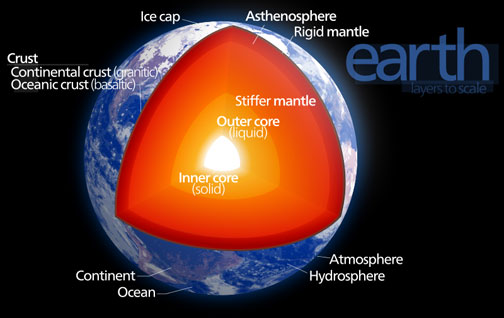“I can tell you that if the amount we have observed is spread out over the entire Earth, there's the potential for there to be more water inside the Earth than in the oceans."
- Steve Jacobsen, Ph.D., Geophysicist, Northwestern Univ.

Earth's solid iron-nickel inner core is 760 miles in diameter (1,220 km) and its surface temperature is as hot as the sun's surface, 10,800 degrees Fahrenheit (6,000 degrees Celsius). The solid inner core's diameter of 2,159 miles (3,474 km) is about 70% the diameter of Earth's moon. The mass of the inner core is about one hundred million million million tons - which is about 30 per cent greater than the mass of the moon. Illustration 2013 Wikipedia by Kevinsong.
June 26, 2014 Evanston, Illinois - 71% of Earth's surface area is water. Earth ocean depths can be as much as five to six miles — and even 6.8 miles deep in the Pacific's Mariana Trench. How did so much water end up on a planet that began as boiling hot with lava all over its surface? This question has baffled scientists for a long time. Theories have included comets crashing into Earth and leaving their ice to melt. But could comets provide all the water that's filled Earth's oceans and seas? No one knows exactly when the first ocean filled, but estimates are as long ago as 3.8 billion years.
Click here to subscribe and get instant access to read this report.
Click here to check your existing subscription status.
Existing members, login below:
© 1998 - 2025 by Linda Moulton Howe.
All Rights Reserved.

